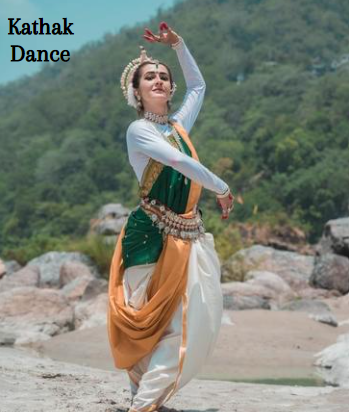Immerse yourself in the enchanting world of Kathak Dance, a classical Indian art form known for its graceful movements, intricate footwork, and expressive storytelling. Discover the rich cultural heritage as dancers weave tales through rhythmic patterns and captivating gestures. Explore the beauty and tradition of Kathak, a dance that transcends time and embodies the soulful spirit of India. Kathak, a classical dance form that originated in northern India, is a mesmerizing journey through rhythm, expression, and storytelling. This ancient art form has stood the test of time, evolving over centuries while maintaining its core essence. In this blog, we will delve into the rich history, intricate movements, and cultural significance of Kathak dance.

Historical Roots of Kathak Dance:
The roots of Kathak can be traced back to the nomadic bards of ancient northern India, known as Kathakars or storytellers. These storytellers used dance, music, and mime to narrate mythological tales and historical events. Over time, Kathak absorbed influences from Persian and Central Asian cultures, especially during the Mughal era. This fusion of Hindu and Muslim traditions resulted in the unique and diverse form of Kathak we see today.
Movements and Expressions:
At the heart of Kathak are its intricate footwork, expressive hand gestures (mudras), and fluid body movements. The dance is characterized by its rhythmic complexity, with performers often engaging in complex foot patterns and spins. The expressions in Kathak are equally important, as dancers convey a wide range of emotions through facial expressions and body postures. The seamless blend of technical precision and emotional depth is what sets Kathak apart.
The Ghungroo:
One of the most distinctive features of Kathak is the ghungroo, a string of small bells tied around the ankles of the dancer. The sound of the ghungroo adds a musical dimension to the performance, accentuating the rhythm and highlighting the dancer’s footwork. The skilled manipulation of the ghungroo becomes a dance within a dance, creating a symphony of sound that captivates the audience.
Narrative Elements:
Kathak is not merely a display of technical prowess; it is a form of storytelling that often incorporates ancient myths, legends, and poetry. Dancers use their bodies to convey the narrative, transporting the audience to a different time and place. The expressive storytelling aspect of Kathak allows for a deep connection between the performer and the viewer.
Costumes and Ornaments:
Traditional Kathak costumes are a visual treat, characterized by vibrant colors and intricate embroidery. The dancers adorn themselves with elaborate jewelry, including maang tikka, necklaces, and anklets, adding to the overall visual appeal of the performance. The costumes and ornaments play a crucial role in enhancing the storytelling aspect of Kathak, helping the audience connect with the cultural and historical context of the dance.
Contemporary Relevance:
While rooted in tradition, Kathak has not remained stagnant. Contemporary choreographers and dancers continue to innovate within the framework of the classical form. The timeless beauty of Kathak allows it to resonate with audiences across the globe, transcending cultural boundaries and creating a universal appreciation for the art.
Conclusion:
Kathak dance, with its intricate movements, expressive storytelling, and cultural richness, stands as a testament to the enduring beauty of India’s classical arts. Whether performed in the sacred halls of temples or on the global stage, Kathak continues to captivate audiences and uphold the legacy of a tradition that has thrived for centuries. As we witness the rhythmic footwork and graceful expressions of Kathak dancers, we are reminded of the profound connection between art, history, and the human experience. Discover the beauty and tradition of this captivating dance form that echoes the soulful spirit of India, where every gesture tells a tale and every step is a celebration of artistic heritage.
Through its dynamic rhythms and evocative narratives, Kathak serves as a vehicle for both performers and audiences to connect with deeper layers of emotion, spirituality, and human experience. Its ability to convey intricate tales, from mythological epics to contemporary narratives, renders it a timeless art form that continues to captivate hearts and minds across generations.
